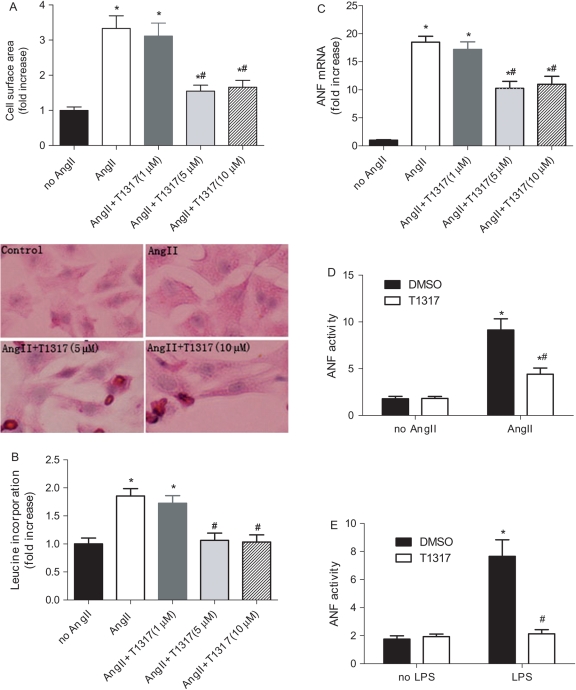Figure 3.
Effect of LXR agonist T1317 on AngII-induced cardiac hypertrophy in RNCM. RNCM were stimulated with 1 µM AngII in the presence or absence of T1317 (1, 5, and 10 µmol/L) that was added 2 h before experiments. (A) Effects of AngII with and without T1317 on cell surface area of cardiomyocytes. Cell surface area was calculated by measuring 50 random cardiomyocytes with Image Pro. (n = 6, *P < 0.05 vs. no AngII, #P < 0.05 vs. AngII alone). Shown are representative images of cardiomyocytes with different treatments. (B) [3H] leucine incorporation was determined by co-incubating cardiomyocytes with 1.0 µCi/mL [3H] leucine for 12 h. Data are expressed as mean ± SEM (n = 6, *P < 0.05 vs. no AngII, #P < 0.05 vs. AngII alone). (C) Real-time PCR analysis of the mRNA levels of ANF in AngII-stimulated cardiomyocytes in the presence or absence of T1317. Data are expressed as mean ± SEM (n = 6, *P < 0.05 vs. no AngII, #P < 0.05 vs. AngII alone). (D) LXR-selective ligand T1317 (10 µmol/L) inhibited AngII-induced luciferase activities driving by ANF promoter in cultured H9C2 myocytes. Data are expressed as mean ± SEM (n = 6, *P < 0.05 vs. no AngII; #P < 0.05 vs. DMSO). (E) LXR-selective ligand T1317 (10 µmol/L) inhibited LPS-induced luciferase activities driving by ANF promoter in H9C2 myocytes. Data are expressed as mean ± SEM (n = 6, *P < 0.05 vs. no LPS; #P < 0.05 vs. DMSO).

